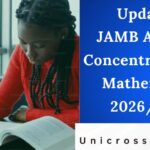Preparing for the Joint Admissions and Matriculation Board (JAMB) Unified Tertiary Matriculation Examination (UTME) is a pivotal step for aspiring Nigerian undergraduates. Among the compulsory subjects, Use of English stands out as the foundation for effective communication and academic success. For the 2026/2027 academic session, the JAMB Use of English syllabus emphasizes practical language skills, critical thinking, and cultural awareness, ensuring candidates can navigate real-world English usage beyond rote memorization.
The Areas of Concentration for Use of English are derived directly from the official JAMB syllabus, highlighting key topics likely to feature prominently in the exam. This guide expands on these areas, providing detailed explanations, examples, and study strategies to help you achieve a score of 70 or higher—a threshold that significantly boosts your overall UTME performance. With the exam’s computer-based testing (CBT) format, familiarity with these concentrations will sharpen your speed, accuracy, and confidence.
Understanding the syllabus is not just about listing topics; it’s about building competence in comprehension, expression, and analysis. The Use of English section typically comprises 60 questions, divided into comprehension passages, lexis and structure, and oral forms. By focusing on these areas, you’ll master sentence construction, vocabulary building, and interpretive skills essential for tertiary education. This expanded resource aims to demystify the syllabus, offering insights into common pitfalls, mnemonic aids, and practice tips. Whether you’re a first-time candidate or retaking the exam, consistent study aligned with these concentrations can transform your preparation from overwhelming to empowering.
As we delve deeper, remember that JAMB’s goal is to test your ability to use English as a tool for learning and expression. Integrate reading novels like the prescribed JAMB text (such as “The Life Changer” from previous years, with updates expected) and practice with past questions to reinforce these concepts. Let’s explore the core areas step by step.

JAMB Areas of Concentration for Use of English
1. Comprehension and Summary
This section evaluates your ability to understand, interpret, and summarize written texts, forming about 40% of the exam. It includes close reading of passages on diverse themes like education, environment, health, and society, followed by questions on main ideas, inferences, and implied meanings.
Key concentrations include identifying the writer’s purpose, tone, and attitude. For instance, passages may discuss climate change, requiring you to discern if the tone is persuasive, informative, or cautionary. Practice summarizing paragraphs in 50-100 words, focusing on central themes while omitting details. Common challenges arise with idiomatic expressions or cultural references; counter this by reading editorials from newspapers to build contextual awareness.
Another focus is drawing inferences from implied information. Questions might ask, “What does the author suggest about technology’s role?”—testing logical deduction rather than direct quotes. To excel, annotate passages during practice: underline topic sentences and circle transitions like “however” or “therefore.” Aim for 10-15 practice passages weekly, timing yourself to simulate exam pressure. This area rewards active reading, turning passive skimming into insightful analysis, ultimately enhancing your critical thinking for university-level discourse.
2. Lexis and Structure
Lexis and Structure, accounting for roughly 30% of questions, probes your command of vocabulary (lexis) and grammar (structure). It’s the backbone of clear communication, with emphasis on word choice, sentence patterns, and idiomatic usage.
In lexis, concentrate on synonyms, antonyms, and homophones—words like “affect” (verb) vs. “effect” (noun). JAMB often tests contextual meanings, such as “bank” as a river edge or financial institution. Build your word bank by learning 20 new words daily, using them in sentences. Idioms and phrasal verbs, like “break down” (fail) or “put up with” (tolerate), frequently appear; flashcards with examples can solidify retention.
For structure, master rules of mood, tense, aspect, number, agreement/concord, degree (positive, comparative, superlative), and question tags. Tenses span simple present (I eat) to perfect continuous (I have been eating), with questions mixing them for error spotting. Concord ensures subject-verb harmony, e.g., “The team is winning” (collective noun). Degrees compare qualities: “good, better, best.” Question tags add confirmation, like “It’s raining, isn’t it?” Practice rewriting sentences to change degrees or add tags. Errors in structure often stem from overthinking; focus on natural flow by diagramming sentences. This concentration fosters precision, vital for essays and reports in higher education.
3. Oral Forms
The oral component, about 20-25% of the paper, assesses spoken English proficiency through phonetic and phonological elements. Though written, it mimics auditory skills, preparing you for oral interviews or presentations.
Prioritize vowels (monophthongs like /i:/ in “see” and diphthongs like /aɪ/ in “buy”) and consonants (e.g., /θ/ in “think” vs. /ð/ in “this”). Syllable division and word stress are crucial—stressed syllables in “examination” fall on “am” and “na.” Emphatic stress highlights meaning, as in “JOHN ate the cake” (not someone else). Rhymes and word classes test auditory discrimination.
Use phonetic transcription apps or mirrors to practice sounds, exaggerating for clarity. Record yourself reading aloud and compare to standard pronunciations. Questions may involve selecting rhyming words or identifying stressed elements in sentences. This area bridges written and spoken English, enhancing overall fluency for global communication.
READ ALSO: Updated JAMB Subject Combination for Computer Science 2025
FAQs
How many questions are in the Use of English section for JAMB 2026/2027?
Expect 60 objective questions, split across comprehension (about 25), lexis/structure (about 20), and oral forms (about 15), lasting 1-1.5 hours.
Is the prescribed novel still relevant for 2026/2027?
Yes, JAMB typically mandates one novel annually; study its themes, characters, and plot for 5-10 questions. Updates are announced during registration.
Can I use dictionaries during the exam?
No, the CBT format prohibits aids, so build vocabulary through immersion. Practice without tools to simulate conditions.
What if I struggle with oral forms?
Focus on phonetic basics via YouTube tutorials. Practice daily pronunciation to improve confidence; it’s more about recognition than perfection.
How do I improve comprehension speed?
Skim for gist first, then detail-scan. Time passages under 5 minutes each, gradually reducing as proficiency grows.
Are past questions enough for preparation?
They’re invaluable for patterns but pair them with syllabus topics for depth. Aim for 10 years’ worth, analyzing trends like recurrent grammar rules.
Does JAMB update the syllabus yearly?
Minor tweaks occur, but core areas remain stable. Check official announcements post-registration for 2026/2027 specifics.







